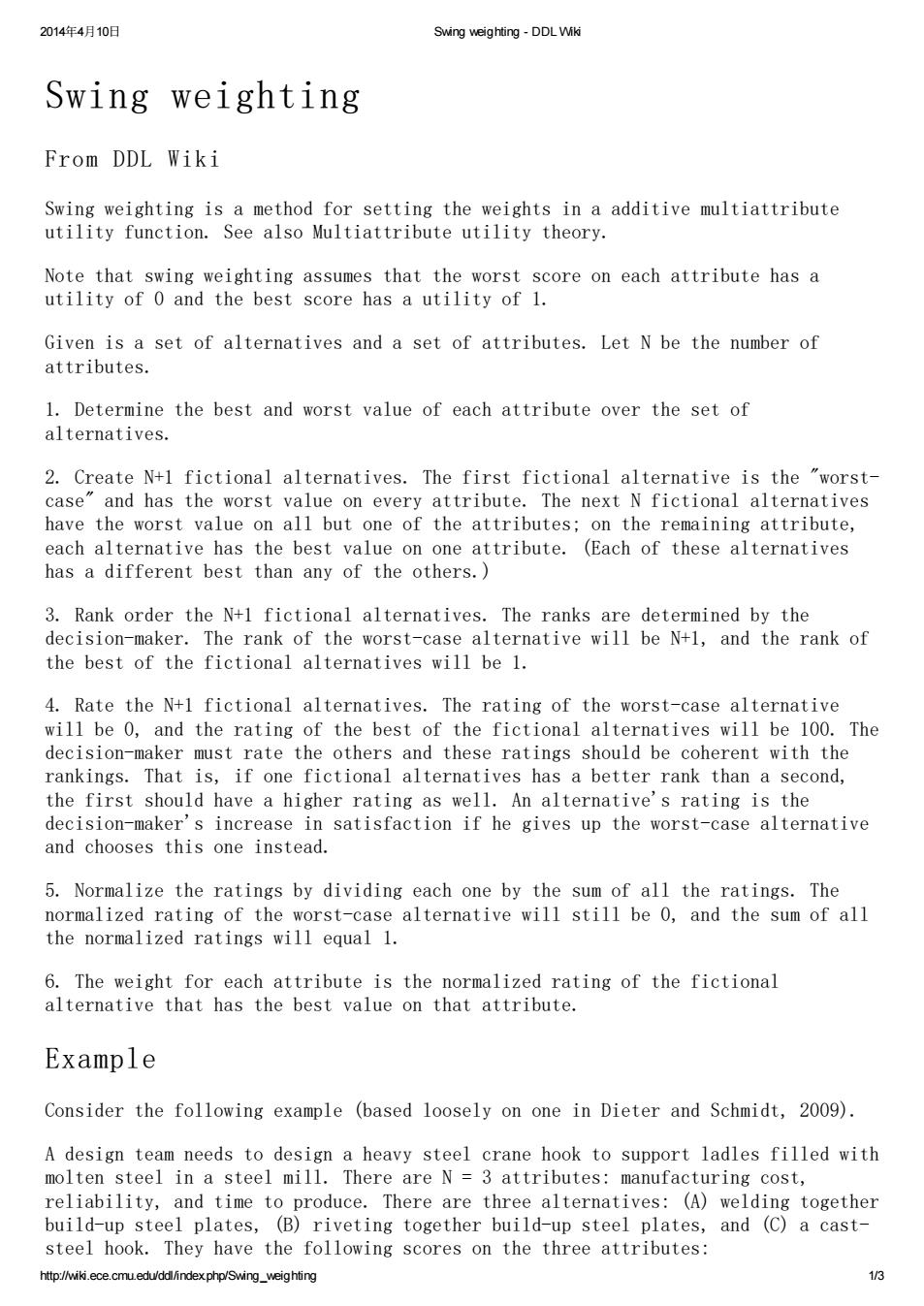正在加载图片...

2014年4月10日 Swing weighting-DDL Wiki Swing weighting From DDL Wiki Swing weighting is a method for setting the weights in a additive multiattribute utility function.See also Multiattribute utility theory. Note that swing weighting assumes that the worst score on each attribute has a utility of 0 and the best score has a utility of 1. Given is a set of alternatives and a set of attributes.Let N be the number of attributes. 1.Determine the best and worst value of each attribute over the set of alternatives. 2.Create N+1 fictional alternatives.The first fictional alternative is the "worst- case"and has the worst value on every attribute.The next N fictional alternatives have the worst value on all but one of the attributes;on the remaining attribute, each alternative has the best value on one attribute.(Each of these alternatives has a different best than any of the others. 3.Rank order the N+1 fictional alternatives.The ranks are determined by the decision-maker.The rank of the worst-case alternative will be N+1,and the rank of the best of the fictional alternatives will be 1. 4.Rate the N+1 fictional alternatives.The rating of the worst-case alternative will be 0,and the rating of the best of the fictional alternatives will be 100.The decision-maker must rate the others and these ratings should be coherent with the rankings.That is,if one fictional alternatives has a better rank than a second, the first should have a higher rating as well.An alternative's rating is the decision-maker's increase in satisfaction if he gives up the worst-case alternative and chooses this one instead. 5.Normalize the ratings by dividing each one by the sum of all the ratings.The normalized rating of the worst-case alternative will still be 0,and the sum of all the normalized ratings will equal 1. 6.The weight for each attribute is the normalized rating of the fictional alternative that has the best value on that attribute. Example Consider the following example (based loosely on one in Dieter and Schmidt,2009). A design team needs to design a heavy steel crane hook to support ladles filled with molten steel in a steel mill.There are N=3 attributes:manufacturing cost, reliability,and time to produce.There are three alternatives:(A)welding together build-up steel plates,(B)riveting together build-up steel plates,and (C)a cast- steel hook.They have the following scores on the three attributes: http://wiki.ece.cmu.edu/ddl/indexphp/Swing_weighting 1/32014年4月10日 Swing weighting - DDL Wiki http://wiki.ece.cmu.edu/ddl/index.php/Swing_weighting 1/3 Swing weighting From DDL Wiki Swing weighting is a method for setting the weights in a additive multiattribute utility function. See also Multiattribute utility theory. Note that swing weighting assumes that the worst score on each attribute has a utility of 0 and the best score has a utility of 1. Given is a set of alternatives and a set of attributes. Let N be the number of attributes. 1. Determine the best and worst value of each attribute over the set of alternatives. 2. Create N+1 fictional alternatives. The first fictional alternative is the "worstcase" and has the worst value on every attribute. The next N fictional alternatives have the worst value on all but one of the attributes; on the remaining attribute, each alternative has the best value on one attribute. (Each of these alternatives has a different best than any of the others.) 3. Rank order the N+1 fictional alternatives. The ranks are determined by the decision-maker. The rank of the worst-case alternative will be N+1, and the rank of the best of the fictional alternatives will be 1. 4. Rate the N+1 fictional alternatives. The rating of the worst-case alternative will be 0, and the rating of the best of the fictional alternatives will be 100. The decision-maker must rate the others and these ratings should be coherent with the rankings. That is, if one fictional alternatives has a better rank than a second, the first should have a higher rating as well. An alternative's rating is the decision-maker's increase in satisfaction if he gives up the worst-case alternative and chooses this one instead. 5. Normalize the ratings by dividing each one by the sum of all the ratings. The normalized rating of the worst-case alternative will still be 0, and the sum of all the normalized ratings will equal 1. 6. The weight for each attribute is the normalized rating of the fictional alternative that has the best value on that attribute. Example Consider the following example (based loosely on one in Dieter and Schmidt, 2009). A design team needs to design a heavy steel crane hook to support ladles filled with molten steel in a steel mill. There are N = 3 attributes: manufacturing cost, reliability, and time to produce. There are three alternatives: (A) welding together build-up steel plates, (B) riveting together build-up steel plates, and (C) a caststeel hook. They have the following scores on the three attributes: